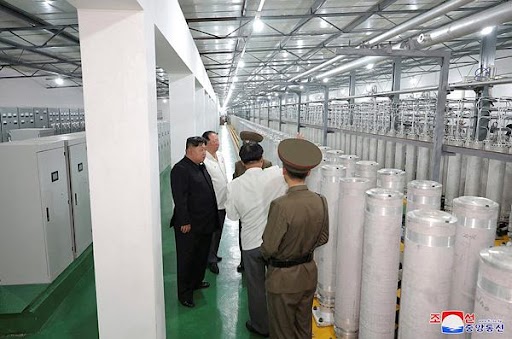North Korea has revealed a rare glimpse inside one of its secretive uranium enrichment facilities, signalling a rapid expansion of its nuclear weapons program. During the visit, leader Kim Jong Un called for a swift escalation in the production of bomb fuel, reigniting global concerns about North Korea’s nuclear capabilities.
Here’s a closer look at the facility, North Korea’s uranium enrichment capabilities, and the potential global ramifications:
What Did North Korea Reveal?
North Korean state media released photos showing Kim Jong Un touring a hall packed with grey centrifuge tubes, likely inside one of its uranium enrichment plants. The exact location was undisclosed, though experts believe it to be in one of the two known facilities in Yongbyon or Kangson, both linked to uranium enrichment activities.
Analysts, including Yang Uk of South Korea’s Asan Institute for Policy Studies, estimate that the centrifuges shown in the photos could number around 1,000—enough to produce 20-25 kilograms of highly enriched uranium annually, sufficient for one nuclear bomb. This marks the first time North Korea has publicly disclosed a uranium enrichment facility since a 2010 visit by Stanford University scholars to Yongbyon.
Why Should We Be Concerned?
While the world already knew of North Korea’s uranium enrichment capabilities, the latest disclosure serves as a stark reminder of Kim’s ambition to exponentially expand his nuclear arsenal. Despite stalled diplomacy with the US and South Korea, Kim has ramped up missile and nuclear programs, boasting about the nation’s ability to counter what he perceives as US-led threats.
Uranium enrichment poses a significant danger. Unlike plutonium, which is easier to detect via satellite due to its large-scale production facilities, uranium centrifuges can be hidden in smaller, undetectable locations such as underground tunnels or factories. Experts estimate North Korea operates around 10,000 centrifuges, producing enough uranium to build 12-18 bombs annually. By 2027, North Korea could accumulate enough bomb fuel to build 200 nuclear weapons.
International Atomic Energy Agency (IAEA) Concerns
In its latest report, the IAEA confirmed ongoing activities at both the Yongbyon and Kangson facilities. The IAEA observed water outflows and operational indications at the 5-megawatt reactor in Yongbyon, which could produce additional weapons-grade plutonium. The agency also noted the construction of a new annexe at Kangson, expanding its capacity.
What’s Next for Nuclear Diplomacy?
Diplomacy between North Korea and the US has been in a deadlock since 2019 when talks broke down over North Korea’s demand for sanctions relief in exchange for dismantling the Yongbyon complex. Although North Korea’s offer was seen as a partial surrender, it was not enough to halt the nation’s nuclear ambitions. Since then, Kim has pushed forward with his nuclear program, likely seeking to establish North Korea as a recognised nuclear power and negotiate from a position of strength.
Some experts predict Kim may attempt to pressure the US in 2024, an election year, by conducting long-range missile tests or possibly a nuclear detonation to showcase North Korea’s growing arsenal.
Parallels with Iran’s Nuclear Programme
Kim’s visit to the enrichment facility draws comparisons to Iran’s Natanz uranium enrichment site, famously visited by former Iranian President Mahmoud Ahmadinejad. Despite Iran’s 2015 nuclear agreement with world powers, the deal collapsed in 2018 when the Trump administration withdrew, and Iran has since advanced its enrichment closer to weapons-grade levels.
North Korea’s recent actions, combined with its known nuclear ambitions, present a growing challenge for global diplomacy, underscoring the urgent need for renewed international efforts to curb its nuclear capabilities.
(With media inputs)

